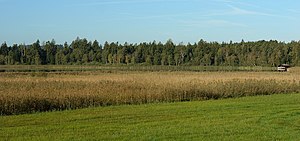Schreckensee (lake)
| Terrifying lake | |
|---|---|

|
|
| Geographical location |
Germany Baden-Wuerttemberg district Ravensburg |
| Tributaries | from Buchsee , Vorsee and small Schreckensee |
| Drain | via Hühler Ach to Schussen |
| Places on the shore | Wolpertswende |
| Location close to the shore | Ravensburg |
| Data | |
| Coordinates | 47 ° 53 '21 " N , 9 ° 33' 52" E |
| Altitude above sea level | 568 m above sea level NHN |
| surface | 30.2 ha |
| volume | 2,138,000 m³ |
| Maximum depth | 12.2 m |
| Middle deep | 7.1 m |
| Catchment area | 6.15 km² |
|
particularities |
|
The Schreckensee is a still water in the area of the Baden-Württemberg community Wolpertswende in the district of Ravensburg in Germany.
location and size
The lake, first mentioned in 1090 in a deed of donation to the Weingarten monastery , lies between Blitzenreute and Altshausen and the hamlets of Schreckensee and Vorsee on the federal road 32 at an altitude of 568 m above sea level. NHN , in the " Schreckensee " nature reserve named after him ( FFH area ) and is owned by the state of Baden-Württemberg.
The size of the lake basin is still 30.2 hectares today (for comparison in 1937: 40.4 hectares), the length and width about 700 meters each. Its maximum depth is 12.2 meters. With an average water depth of 7.1 meters, the lake volume is 2,138,000 cubic meters. The catchment area of the Schreckensee covers about 615 hectares; 45 percent of this is forests and 34 percent is land used for agriculture. The shore length is around 2,600 meters.
Emergence
Like the nearby Buchsee and Vorsee, the Schreckensee emerged as a meltwater lake around the end of the last Ice Age around 16,000 years ago.
ecology
| 1989 | 1994 | 1998 | 1999 | 2004 | ||
| Total PO 4 - phosphorus | (µg / l) | 61 | 38 | 53 | 58 | 47 |
| anorg. Total nitrogen | (mg / l) | 0.85 | 0.72 | 0.58 | ||
| Chlorophyll a | (µg / l) | 6.3 | 9.9 | 20th | ||
| Chlorophyll a tip | (µg / l) | 14th | 16 | 28 | ||
| Depth of view | (m) | 2.2 | 2.0 | |||
| Annual averages | ||||||
| Buchsee | Little scare lake | Vorsee | ||
| o-PO 4 - phosphorus | (µg / l) | 9 | 9 | 24 |
| Total PO 4 phosphorus | (µg / l) | 70 | 67 | 95 |
| anorg. Total nitrogen | (mg / l) | 1.48 | 2.77 | 1.10 |
| Nitrate- nitrogen | (mg / l) | 1.21 | 2.51 | 0.70 |
| Annual averages 2004 | ||||
With the help of the action program for the rehabilitation of Upper Swabian lakes , the planning of extensification measures was carried out and implemented since 1993.
flora
The white water lily ( Nymphaea alba ), which is a typical representative of floating leaf plants, and the yellow pond rose ( Nuphar lutea ) grow in the lake . The plants protected in Germany prefer stagnant or sluggishly flowing water with a humus silty soil as a habitat. Also the milfoil ( Myriophyllum spicatum ), it grows quite often in diving leaf communities, eutrophic , but not polluted, rather calcareous, stagnant water with silty subsoil, can be found. Blue-green algae also live in the Schreckensee .
fauna
Until 1991 u. a. Eel , perch , pike , carp , roach , rudd , tench , bleak , catfish and pikeperch are present in the lake. From the worth protecting wildlife following birds are species (selection) to name: Common Snipe , Blässralle , grebes , black-headed gull ( Larus ridibundus ), reed bunting , reed warbler , Little Bittern and Jack Snipe .
Others
On the peninsula in Schreckensee, Heinrich Forschner , a Biberach dentist and amateur prehistorian, discovered a prehistoric moor settlement (Stone Age pile dwellings ) in 1921 . In the period that followed, the exact location of the settlement was forgotten; it was not until excavations by the State Monuments Office in 1979 and 1983/84 that their remains were unearthed and objects of the so-called Pfyn-Altheimer group were found, which are a spatial link between the Pfyn culture (Switzerland / Lake Constance ) and the Altheim culture on the Iller . The site is part of the UNESCO World Heritage Site “ Prehistoric pile dwellings around the Alps ”.
